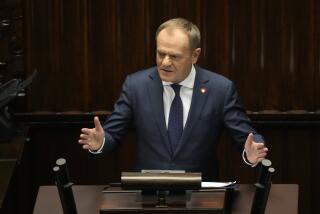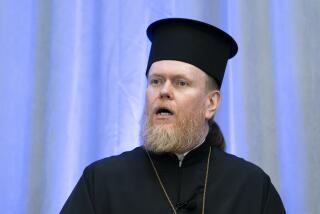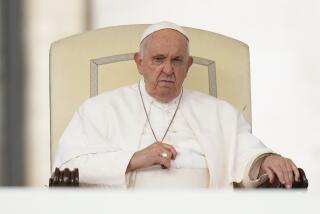A Much-Changed Poland Awaits Pope : Religion: The church has been taking its lumps on issues from abortion to education.
- Share via
WARSAW — Pope John Paul II, arriving today for a fourth papal pilgrimage to his homeland, will find a very different Poland from the one he encountered on his last visit in 1987.
Then, the Communists were still in power, the trade union Solidarity was illegal, the shops were empty and the visit of the Polish Pope was an event of brightness and excitement in a long, bleak period of political and economic gloom.
Back then, the pontiff teasingly milked every ounce of drama out of his use of the word solidarity, using it initially with a small “s” in reference to “Christian solidarity,” and finally, near the end of his trip, in a dramatic outdoor Mass in Gdansk, taking up the proper name of Solidarity, the union and the political movement it represented.
The Mass ended with an overtly political march by Solidarity activists and a head-bashing clash with the dreaded Zomo riot police.
Now the Zomo are disbanded. The shops of Warsaw and Gdansk and other cities are filled with bright (and expensive) consumer goods. A flashy minority of newly affluent Poles--traders, merchants and sharp operators working within the law and often just beyond its vague fringes--zoom through the streets in their slick new BMWs and Mercedeses. For some, a new religion of conspicuous acquisitiveness has arrived.
At the same time, the Roman Catholic Church, which claims as adherents about 93% of the population, has been taking its lumps, in a manner that some say has been self-inflicted.
A recent public opinion survey indicated that respect for the church, as a national institution, had dropped to second place, behind the army. A government poll this week showed that more than half of Poles think the church’s role in public affairs is too great, and more than 60% want to see a guarantee of church-state separation written into the constitution. Some say an anti-church backlash has begun to appear in Poland.
Its critics say the church has begun to meddle too much in the schools, the bedroom and politics, and has been acting as though it were calling in its markers for its years of serving as a refuge for the political opposition and a haven of freedom throughout the long years of totalitarian rule.
The church angered many parents last September when priests suddenly turned up at the opening of schools to begin teaching religion classes, long banned during the Communist era.
That surprise was followed immediately by the church’s drive to get a strict anti-abortion law passed by Parliament. The legislation was debated intensely for three days last month. A vote on the question was delayed by the nervous legislators, who were aware that a large part of the public opposes the law but who are also aware that the church could easily ruin individual chances for reelection in October.
Much of this disquiet over the church’s activities in Poland--including the presence of priests at state functions ranging from the dedication of a new ambulance to the opening of Parliament--does not necessarily rub off on Pope John Paul II, who remains far and away the most respected world figure for Poles.
Millions are expected to turn out to see him on the nine-day trip--but perhaps fewer millions than have turned out on previous journeys. And there may even be a few dissenters.
“I would not exclude some protest demonstrations or reserved receptions,” said Father Stanislaw Opiela, head of the papal visit press bureau.
“Some people say there is an excessive church presence now, for example in the media. These people may express their views during the visit . . . but they would not be well received by the majority,” Opiela added.
Of course, many Poles credit the Pope’s first visit here in 1979 with paving the way for the protests that led to the formation of Solidarity a year later. By extension, many intellectuals credit the elevation of an Eastern European cardinal to the papacy as a key event in the chain of circumstances that led to the Communist collapse in 1989.
In the new economic and political climate, church experts expect the Pope to warn Poles against losing sight of spiritual values in their rush to catch up with the West. Some expect the pontiff’s message to be more stern than in the past.
Believers should gain “true knowledge of his entire catechism--listening not only to the ‘Pope for human rights’ but also to the ‘Pope for Christian and civic duties,’ ” said Stefan Frankiewicz editor of the church-linked monthly Wiez.
The Pope’s trip includes 12 cities, mostly in eastern Poland, where he is expected to make a special appeal across the Soviet border to Ukrainians, Byelorussians and Lithuanians. Extra border crossings have been opened for as many as 30,000 Soviets who may want to come to Masses that have been scheduled just across the frontiers in Polish territory. This is a contrast from previous papal visits when the Communist authorities discouraged events in eastern Poland in deference to the Soviets.
In the southeastern Polish town of Przemysl, the Pope will find himself in the midst of a raging local controversy involving Polish and Ukrainian Catholics. The Pope had planned to meet with the Ukrainians in a cathedral that the Polish Catholics were to turn over to the Ukrainians. But the Polish Catholics have barricaded themselves inside the cathedral.The scheduled papal meeting is now uncertain.
It is similarly uncertain whether the Pope will counsel church leaders in Poland to ease their involvement in political affairs, but the Vatican may not be pleased to hear that the church’s top official in Poland, Cardinal Jozef Glemp, is referred to as “Ayatollah Glemp.”
More to Read
Sign up for Essential California
The most important California stories and recommendations in your inbox every morning.
You may occasionally receive promotional content from the Los Angeles Times.










